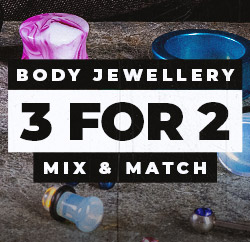Are you sure you want to perform this action?

GBP
Select Language
English (United Kingdom)
English (United States)
French (France)
German (Germany)
Italian (Italy)
Spanish (Spain)
Show menu
Hide menu
Clothing
Dresses
Hoodies & Sweatshirts
Jackets & Coats
Jumpers & Cardigans
Pinafores & Dungarees
Shirts & Tops
Jeans & Trousers
Skirts
T Shirts & Vests
View All
Autumn & Winter
Gothic
Kawaii
Spring & Summer
Steampunk
Tartan
TV & Movie Merch
Vintage
Witchy
View All
Gifts & Accessories
Band Merch Gifts
Bath Bombs
Fantasy Gifts
Gothic Gifts
Piercing & In-Store Voucher
Gothic Hair Accessories
Pop Culture Gifts
Stocking Fillers
Xmas Tree Decorations
View All
Hair Dye
Piercing Jewellery
Acrylic
Black Titanium
Coloured Titanium
Opal
Polished Titanium
Plasma Gold
Real Gold
Rose Gold
Silicone
Surgical Steel
Ultra Violet
White Gold
Wood
View All
Auricle
Anti-Tragus
Conch
Daith
Forward Helix
Helix
Industrial / Scaffold
Lobes
Orbital
Pinna
Rook
Scapha / Flat
Snug / Anti-Helix
Spiral / Triple Helix
Stretching
Tragus
View All
Angel Bites
Ashley
Canine Bites
Cyber Bites
Dahlia Bites
Dolphin Bites
Jestrum
Labret
Madonna
Medusa
Monroe
Shark Bites
Snake Bites
Spider Bites
Vertical Labret
Viper Bites
View All
Collarbone
Extreme Mods
Female Genital
Genital
Hand
Hip
Male Genital
Navel
Neck (Nape)
Nipple
Sternum / Cleavage
Surface
Wrist
View All
Contact Lenses
Get Pierced
Ear Piercing Aftercare
Nose Piercing Aftercare
Oral Piercing Aftercare
Surface Piercing Aftercare
Microdermal Piercing Aftercare
Genital Piercing Aftercare
Aftercare
Sections
Latest articles
Getting Re-Pierced
Want to get re-pierced? Find more information about the piercing procedure and healing process for re-piercing.
For many people, getting re-pierced can be a stressful and emotive issue. Sometimes people have had to retire a piercing for traumatic reasons (trauma to the piercing, an injury or for health reasons) so the re-piercing process can be rather cathartic. For others, a re-piercing is simply a means of achieving their ideal aesthetic. Whatever your reason for seeking a re-piercing, make sure you visit a fully trained piercer at a reputable piercing studio to ensure the process is handled safely and professionally.
It can be difficult for some people to understand the reasons behind wanting to get something re-pierced, though this is typically due to a lack of comprehension regarding the personal choices behind getting a piercing. For example, it's common to opt for a re-piercing if you've had to remove your jewellery for the following reasons:
- Surgery
- Pregnancy
- Migration
- Rejection
- A change in dress code at school or work
- Illness
- Issues with healing
- Extreme weight gain or loss
There are also plenty of people who choose to get re-pierced after having previously retired a piercing simply because they were too forgetful to re-insert jewellery or wanted a change in their personal style.
It's important to remember that certain piercings (in particular, nostril piercings) can heal over extremely quickly, sometimes in as little as a few hours. In cases such as these, it's essential to refrain from attempting to force jewellery through the hole, no matter how tempting it may be to do so. It's advised to allow the piercing to completely heal (a few months or so is usually sufficient) before getting it re-done, as this will allow the tissue to fully repair itself.
Procedure
Before you can go ahead and get re-pierced your piercer should perform an examination of the area to assess the viability of your request. After checking that the tissue is healthy and able to support being re-pierced, your piercer will be able to tell you whether you are able to have your piercing performed in the same location or if you will need it in a slightly different location due to scar tissue or migration issues.
In most instances, you should be able to have the original piercing channel re-opened or re-pierced. In many cases, the internal channel (i.e. where the jewellery sits inside your body) remains relatively intact, with only the entry and exit points healing over, making the re-piercing process simple and relatively un-traumatic.
If you had to retire your piercing due to migration, injury or rejection, you may discover that you cannot be pierced in the exact same location as before. Most piercers will place the new piercing behind any pockets of scar tissue to ensure the piercing is in a more viable location, though it is worth remembering that as scar tissue is weaker in construction than the skin1, this method doesn't necessarily guarantee success. Many individuals find that they experience no issues following this type of piercing, though some people may encounter problematic healing due to the presence of the scar tissue. As with any piercing, we advise discussing everything fully with your piercer before taking the plunge, to ensure you aren't left with any nagging questions or nasty surprises.
1: Angel, E. (2009) The Piercing Bible, Berkley: Crossing Press
Pain
Some people find that getting their piercings re-done is more painful than when they had the initial piercing, though others report a virtually painless experience. It's worth bearing in mind that everyone experiences pain differently, so this evidence is purely anecdotal.
Healing
If you're re-pierced in the same spot (using the original inner channel), then you may find you heal a little faster than before due to the fact that the majority of healing had been done the first time around and the amount of trauma to the area is minimal.
If your piercing is performed in a slightly different location, then your healing time will be a little longer, as is the case with any fresh piercing.
Jewellery
As with a brand new piercing, the jewellery you are given to wear in the initial healing stage will be specially chosen to allow for any swelling that may occur following the piercing. This jewellery is usually a little longer and larger in diameter than you may prefer to wear but it's essential that you keep it in for the entirety of the healing period as changing your jewellery too early can cause irritation, infection, and potential rejection.
Once your piercing has fully healed, you can then change your jewellery for something with a little more personality. From simple BCRs and practical Curved Barbells to pretty navel bars and bold add ons to transform your look, we've got a little something for every taste in our Piercing Jewellery shop!
If you plan to wear jewellery of a larger gauge or intend to significantly stretch your piercing, we recommend discussing this prior to getting the piercing or paying a visit to your piercer (Once you've fully healed, NOT before!) to ensure your piercing can accommodate stretching and that your anatomy is suitable, prior to changing your jewellery. For more information about safely stretching your piercings, check out our informative article on Ear Stretching.
Please Note: Blue Banana piercing information is based on knowledge from our experiences as one of the UK's top piercing studios. All details provided should be read alongside professional advice. Please see our full Piercing Articles Disclaimer, here.
Phone Lines Open
If you need assistance, phone lines are open. Call +44 (0)1579 341907. Or, if you prefer, please open a support ticket here.
OPENING TIMES
Monday:
08:30:am
-
16:30:pm
Tuesday:
08:30:am
-
16:30:pm
Wednesday:
08:30:am
-
16:30:pm
Thursday:
08:30:am
-
16:30:pm
Friday:
08:30:am
-
16:30:pm
Saturday:
Closed
Sunday:
Closed







